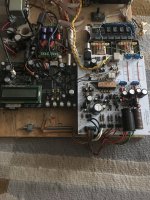The little surface mount that is the closest to tda pins. Looks grey to me so surely a class 1 ceramic. If brown a class 2 as there was in the old cd players from Philips or Marantz for instance.
An equipment could measure well but sound bad and vice versa as we all know. I bet the ukrainian dac performs bad but has globs of h2 h3 and sounds rather pleasant. Which's whats needed in the reproduction chain more often than we care to admit because theres just no other way around bad recordings.
Abbas 2.2:
No doubt that it could sound "pleasing" with various material/files/recordings.... limited to S/PDIF only, though. Looking at the above photo, it is easily evident that a lot of tuning by ear took place. I personally do not have anything against that approach, it could yield a very nice result.
Nice. Looks like he handwinds psu inductors, and damps el caps (questionable practice)
No doubt a passion project. Technically excellent? I dunno, hes not even twisting his wires 😆
No doubt a passion project. Technically excellent? I dunno, hes not even twisting his wires 😆
I dunno, hes not even twisting his wires 😆
If i may borrow ZM's lingo: twisting wires is for sissies 🙂 Besides, it sounds bad.
I find the philosophy behind the Abbas creations deeply inspiring. The obsession with ancient, pre-war parts, wire and especially iron, the complete lack of interest in modernity. Not my philosophy and quite possibly not my sound, but he is driven by real and rare passion. These are products with stories behind them.
And there are no big secrets about his circuits and topologies. Perhaps not all details are shown, but anyone can build a tube DEM oscillator following his published circuits, or a hybrid Si-Ge I/V.
Huh?!?! Standard practice sounds bad?If i may borrow ZM's lingo: twisting wires is for sissies 🙂 Besides, it sounds bad.
Some transformer wires in the Abbas are twisted BTW. So if you untwist them it will be even better 🙂
Twisted wires are for mostly for magnetic field cancellation. However, they may have more capacitance than loosely paralleled wires. Which is the biggest problem in a given situation?
That extra few pF cable capacitance in the AC wiring makes the difference?!? According to some jitter makes DACs sound better too just like mediocre PSUs.
On the other hand, I have had a medium here stray in positive energy in one of my DACs and it was a lot better after that.
On the other hand, I have had a medium here stray in positive energy in one of my DACs and it was a lot better after that.
Last edited:
...ethernet cables... but it is at higher frequencies and longer distances in complex electro magnetic environments (around others cables and twisted pair in a same cable, nowadays twisted pairs are individually shielded ; since cat5e cables
For AC power it makes a lot more sense to twist.That extra few pF cable capacitance in the AC wiring makes the difference?!?
The Abbas guy seems to adhere to normal procedures in this aspect. AC wiring twisted, shielded cable for signals. Good guy.
Who twists signal wiring? Shielded cable is the normal choice.
Professional audio cable is usually twisted and shielded.
Coax cable or simple shielded cable has no twisting normally. On the picture it seems AC wiring of the secondary windings is twisted but I may be seeing things. Anyway, who cares? 🙂 It has the tubes and the magic so all is good.
Transmission lines with good terminations are often critical in high frequency networks, and I have done up to 12 layer circuit boards with variant interleaved power supply planes for use with an array of gamma radiation detectors in a 3D imaging system. However In audio there seems other factors at play as seemingly more critical than high bandwidth. My suspicion is that interleaved dielectric materials in pc boards is an issue important in audio. That reduced capacitance, as in using single layer boards (perhaps even phenolic based) reduces capacitance as thereupon reducing dielectric absorption/release.
In the past I have used "lightly" twisted "magnet wire" (perhaps 3" per full turn) for interconnects (with and without an overall shield). I prefer magnet wire as the coating prevents oxides and allows only a copper core, as opposed to tin/copper or silver/copper. This is not to suggest I have done any physical testing.
In the past I have used "lightly" twisted "magnet wire" (perhaps 3" per full turn) for interconnects (with and without an overall shield). I prefer magnet wire as the coating prevents oxides and allows only a copper core, as opposed to tin/copper or silver/copper. This is not to suggest I have done any physical testing.
In the cases I was shown twisted (unshielded) RCA interconnects the cell phone test and a high bandwidth oscilloscope were pretty decisive.
Here it comes... when listening was done with cell phones at a safe distance those cables were often preferred. Too bad many houses are full of self chosen RF pollution today.
Here it comes... when listening was done with cell phones at a safe distance those cables were often preferred. Too bad many houses are full of self chosen RF pollution today.
Last edited:
I found this as well... though I wouldn't say this out loud.Here it comes... when listening was done with cell phones at a safe distance those cables were often preferred. Too bad many houses are full of self chosen RF pollution today.
- Home
- Source & Line
- Digital Source
- Why all the love for TDA1541?
